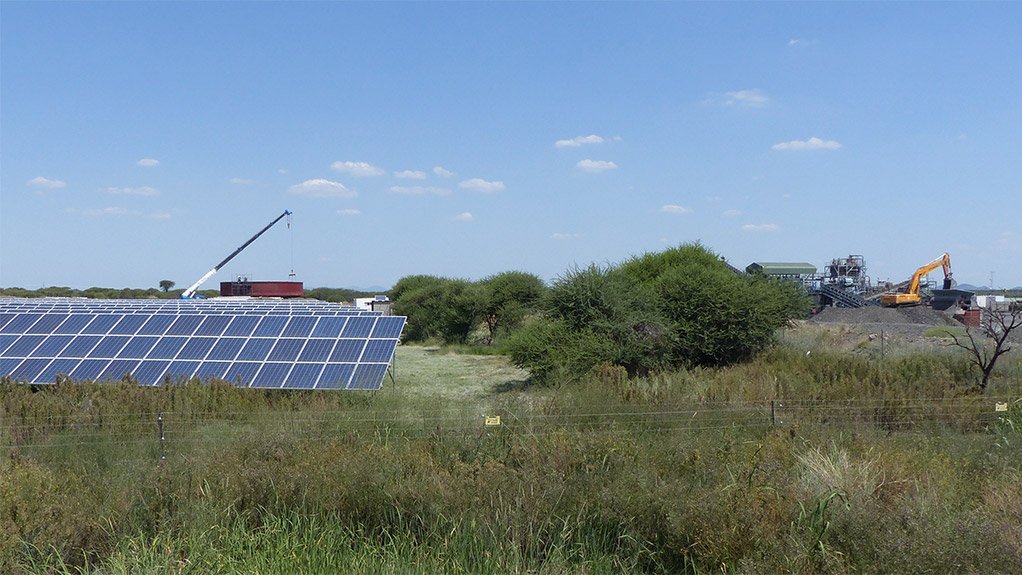Cost benefits to boost mines' adoption of renewable hybrids


UPWARD TRAJECTORY Mining companies are expected to leverage increased competition between independent power producers for more cost-effective hybrid solutions
Photo by THEnergy
As various projects have demonstrated the value of renewables for reducing diesel, heavy fuel oil (HFO) and gas consumption, mining companies could now benefit from a significant cost reduction potential, said renewables research organisation ThEnergy MD Dr Thomas Hillig.
“In the last few years, more and more mining companies have adopted wind and solar systems to reduce their energy costs at remote off-grid mines,” he noted in a report co-authored by international renewable solutions provider Voltalia. The report was released last week.
Hillig added that during the first phase of adoption, the initial focus was on the integration capabilities as miners were afraid that adding intermittent renewables such as solar and wind would affect the reliability of power supply and even lead to production losses.
“In various microgrid applications, renewables combined with diesel, HFO, or gas have proven to provide reliable power supply to remote mines,” Hillig noted, adding that as a result integration of renewables have had positive connotations for the company’s energy cost position.
Moreover, mining companies no longer necessarily have to invest their own capital, as independent power providers (IPPs) invest in the renewable energy infrastructure and sell electricity to mines through power purchase agreements (PPAs).
“This new, second market phase is characterised by price competition”, explained Hillig. “With the support of a leading renewable energy player, the new report analyses how IPPs can offer extremely competitive PPAs to remote miners.”
He stated that large IPPs typically take advantage of economies of scale on components for solar and wind power plants for both remote mining projects as well as for much bigger grid-connected plants.
“Market leaders have managed to optimise the planning and construction processes substantially. However, conducting projects in remote locations, especially in Africa, requires extensive experience. Amongst the challenges of undertaking projects in Africa is financing, which requires an excellent relationship with local and international banks,” he added.
Nonetheless, Hillig stressed that cost optimisation does not necessarily mean minimising capital expenditure but rather focusing on the total lifetime cost of the project and including operation and management.
“It is also important to take the interplay of the different energy sources into consideration. Not every kWh of solar and wind energy generated means equivalent fossil fuel savings,” he said, noting that when gensets run at suboptimal loads – as they might when combined with renewable energies – they lose efficiency and require additional maintenance, which has cost implications.
“During the last 14 years, we have gained experience in renewable energy projects including solar-diesel hybrid microgrids, projects in remote locations and in developing countries,” Voltalia hybrid solutions head Alexis Goybet pointed out.
He commented that Voltalia’s experience has enabled it to employ economies of scale in procurement and that this has translated into significant overall cost-reductions in the range of 20% to 30% relative to new market entrants.
“These overall cost reductions will make solar and wind energy extremely attractive for many mines. The number of remote mines that add renewables to diesel, HFO or gas is expected to grow quickly all over Africa,” Hillig concludes.
Comments
Announcements
What's On
Subscribe to improve your user experience...
Option 1 (equivalent of R125 a month):
Receive a weekly copy of Creamer Media's Engineering News & Mining Weekly magazine
(print copy for those in South Africa and e-magazine for those outside of South Africa)
Receive daily email newsletters
Access to full search results
Access archive of magazine back copies
Access to Projects in Progress
Access to ONE Research Report of your choice in PDF format
Option 2 (equivalent of R375 a month):
All benefits from Option 1
PLUS
Access to Creamer Media's Research Channel Africa for ALL Research Reports, in PDF format, on various industrial and mining sectors
including Electricity; Water; Energy Transition; Hydrogen; Roads, Rail and Ports; Coal; Gold; Platinum; Battery Metals; etc.
Already a subscriber?
Forgotten your password?
Receive weekly copy of Creamer Media's Engineering News & Mining Weekly magazine (print copy for those in South Africa and e-magazine for those outside of South Africa)
➕
Recieve daily email newsletters
➕
Access to full search results
➕
Access archive of magazine back copies
➕
Access to Projects in Progress
➕
Access to ONE Research Report of your choice in PDF format
RESEARCH CHANNEL AFRICA
R4500 (equivalent of R375 a month)
SUBSCRIBEAll benefits from Option 1
➕
Access to Creamer Media's Research Channel Africa for ALL Research Reports on various industrial and mining sectors, in PDF format, including on:
Electricity
➕
Water
➕
Energy Transition
➕
Hydrogen
➕
Roads, Rail and Ports
➕
Coal
➕
Gold
➕
Platinum
➕
Battery Metals
➕
etc.
Receive all benefits from Option 1 or Option 2 delivered to numerous people at your company
➕
Multiple User names and Passwords for simultaneous log-ins
➕
Intranet integration access to all in your organisation


















